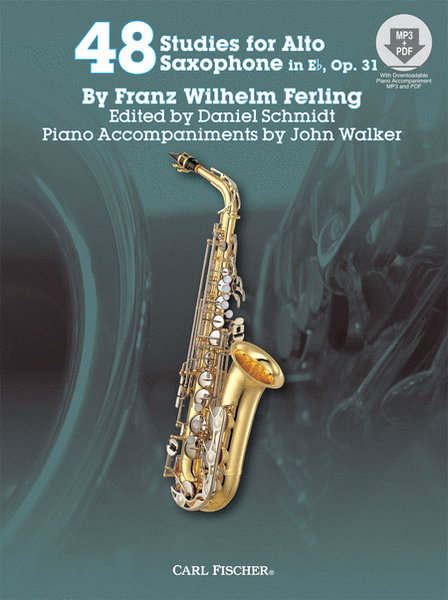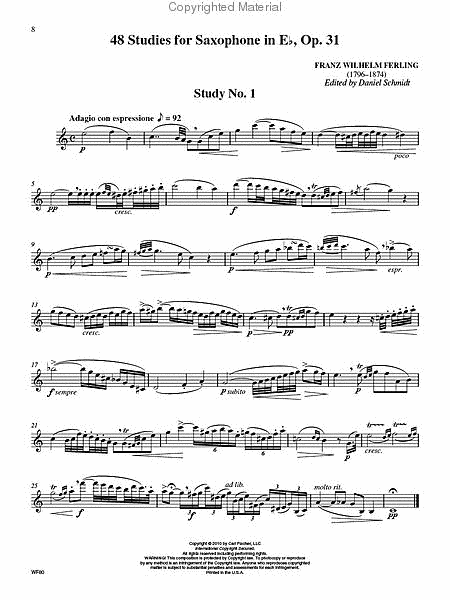48 Studies for Alto Saxophone in Eb, Op. 31
-
Ships in 1 to 2 weeks
Details
Description
SKU: CF.WF80
Composed by Franz Ferling. Edited by Daniel Schmidt. Arranged by John Walker. SWS. Back To School. Book and CD. With Standard notation. 56 pages. Carl Fischer Music #WF80. Published by Carl Fischer Music (CF.WF80).ISBN 9780825873010. UPC: 798408073015. 9 x 12 inches.
What a tremendousopportunity thisbook provides for theyoung performer! Forthe first time ever,one can play theFerling etudes withaccompaniment.This book providesthe tried-andtrueeducation ofthese 48 fantasticexercises, butsupplemented withdownloadableaccompaniments,updating theexperience to matchthe multi-sensorymethod of learningtaking place in somany facets of astudent’s overalleducation.
The Ferling etudes have long been a staple of oboists and saxophonists alike. Theseexercises create fluency in articulation, phrasing, evenness of tone and line, ornamentation,and overall musical sophistication. All of the odd-numbered etudes feature aspects of slow,lyrical playing, while all of the even-numbered etudes feature speedy, technical exercisethat will enhance facility and articulation. A few suggestions for the preparation of thesetwo very different styles of musical performance are given below.Lyrical EtudesOf course, the lyrical etude is slower in nature and should enhance your phrasingand musical abilities, emphasizing the aspects of warmth, grace, elegance, beauty, andrefinement in your performance. Give special attention to the note values within the etude;often with such etudes, players will ignore rests and full values on the longer tones foundthroughout the etude. Believe it or not, pulse is important, also. Do not rush these etudes.Rehearse the slower etude with a metronome—tempo and style marking are provided foreach—to make sure that you are counting through the long tones and that you are not rushingthe tempo. While it is desirable that you may wish to employ a sense of rubato (literally,this means “to rob,” from the Italian word, rubare), cantabile (in a singing style), or otherrhapsodic elements in your performance, make sure that you have a clear understandingof the underlying tempo and note rhythms first. Pay particular attention to breath marks;you may even have to incorporate your own additional phrase marks. In the preparation ofsolo repertoire, it is imperative that breath marks are placed to facilitate the natural breakswithin larger phrase structures, and not occur randomly with little musical purpose. This isone of the most difficult assignments that the wind musician can execute, and the successof this often determines the overall success of the etude. In fact, the phrase marks that arepresent throughout these etudes constitute musical punctuation, and should be regarded asmusical lifts, as they are setting off a specific separation of phrases as dictated by the music.Another stumbling block may be that performers often ignore intonation, as theyfocus on other aspects during the performance of etudes and repertoire. Take the first noteof each phrase and play this tone, in the dynamic as specified with the proper articulation,against a tuner. Remember what was necessary to place this tone in tune. Do the sameexercise with the last note of the phrase. Then play the whole phrase and check the pitchon the last tone. Perhaps you could find the climax of the phrase. Then play the phrase, andsustain the tone that is the climax; check it against the tuner (also, how does the tone sound:is this a desirable tone for this note in the phrase?). Do the same exercise with the lowestnote of the phrase, the highest note of the phrase, or maybe the longest note of the phrase.All of these exercises will help you become more aware of the importance of thelyrical etude and repertoire, as these are the very concepts that constitute musical awareness.These etudes will also help increase your musical experience as well, as they begin to pointyou in the direction of true artistry. Keep in mind that lyrical means songlike; characterizedby emotion, subjectivity, and imagination.Technical EtudesThe technical etude should help to develop the performer’s ability to play smoothlyand evenly throughout the range of the instrument. Simply playing the tones at theprescribed tempo is not enough, however. The performer must demonstrate musicianshipthat transcends the mere execution of the right tones and correct articulations. The playermust have an excellent idea of the overall shape of the etude: where the musical peaks andvalleys are located, how dynamic contrasts fit into the shape, and the significance of thevariety of articulation (or lack thereof). Without these considerations, the technical etudeserves little purpose.The process in which the technical etude is prepared is very similar to that of thelyrical etude, in fact. The same approach with initial note values is necessary. Give specialattention to the note values within the etude; often with such etudes, performers willignore rests and full values on the longer tones found throughout the etude. Do not rushthe learning process for these etudes. Rehearse the technical etude with a metronome—anultimate tempo marking is provided for each, but begin much more slowly—to make surethat you are counting through the long tones and that you are not rushing the tempo. Whenbeginning the technical etude, use the same approach that you utilize during the preparationof scale and arpeggio patterns. In fact, if the preparation of scales and arpeggio patternsis proper, this will facilitate the preparation of the technical etude, as these etudes oftencomprise such patterns.Set the metronome to a slow and reasonable marking, and begin to play the etude.If you have picked a speed that is too slow, then you will simply experience great successin its preparation. After you have mastered this tempo—but only after you have masteredthis tempo—increase the speed of the metronome by one click (four beats per minute).Remember: increase the speed only when you have mastered the previous tempo. It ismuch easier to learn these patterns from scratch, as opposed to “re-learning” them, rifewith wrong fingerings, articulations, unevenness, and a myriad of other bad habits. Whilethis process may seem slow and tedious, this is the shortest distance between two points, infact. If you skip the mastery of each step to simply crank up the tempo on the metronome,then the product of your practice will be an uneven, “dirty” etude, and you are simplywasting your time. For this reason, it is recommended that you do not write in breath marksuntil the tempo is close to the suggested tempo, as breath marks may change with theincrease of speed. In addition, try to make sure that the breath marks fit the overall phrasestructure, and are not placed solely for the purpose of facilitating your breath. Sometimesthis may not be possible in a long run of tones, and it is permissible to leave a tone out,as long as the pulse is not interrupted. Not only will a properly prepared Ferling technicaletude demonstrate great instrumental technique, or flash, but it will also demonstrate theperformer’s understanding of the importance of diligence and work ethic, and demonstratethe performer’s ability to practice in a methodical, structured manner.Keep in mind that there are style markings for these technical exercises as well asmetronome markings, giving further guidance for a sophisticated musical interpretation ofthese etudes.Special thanks should go out to my good friend and oboist Nancy Clauter for hercareful suggestions on articulations and phrasing, as well as her biography on Ferling,included in this book. John Walker’s diligent work on the piano accompaniment brings thisnew experience to life. Enjoy!—Daniel Schmidt.


 Share
Share